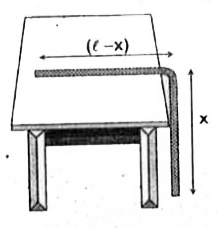A heavy uniform chain lies on horizontal table top. If the coefficient of friction 0.25, then the maximum fraction of length of the chain that can hang over on one edge of the table is
20%
25%
35%
15%
The correct Answer is:A
To solve the problem of determining the maximum fraction of length of a heavy uniform chain that can hang over the edge of a table given a coefficient of friction of 0.25, we can follow these steps:
Step 1: Define Variables
Let:
- L = total length of the chain
- h = length of the chain on the table
- L−h = length of the chain hanging over the edge of the table
Step 2: Determine Masses
The total mass M of the chain can be expressed in terms of its length:
- Mass of the part on the table: mtable=hL⋅M
- Mass of the part hanging: mhanging=L−hL⋅M
Step 3: Calculate Forces
The normal force N acting on the part of the chain on the table is equal to the weight of the chain on the table:
- N=mtable⋅g=hL⋅M⋅g
The maximum static friction force Fs can be calculated as:
- Fs=μs⋅N=0.25⋅hL⋅M⋅g
The weight of the hanging part of the chain is:
- W=mhanging⋅g=L−hL⋅M⋅g
Step 4: Set Up the Equation for Equilibrium
For the chain to be in equilibrium, the maximum static friction force must equal the weight of the hanging part:
Fs=W
Substituting the expressions we derived:
0.25⋅hL⋅M⋅g=L−hL⋅M⋅g
Step 5: Simplify the Equation
Cancel M⋅g from both sides:
0.25⋅hL=L−hL
Multiplying through by L:
0.25h=L−h
Rearranging gives:
1.25h=L
Thus,
h=L1.25=4L5
Step 6: Calculate the Length Hanging Over
The length of the chain hanging over the edge is:
L−h=L−4L5=L5
Step 7: Find the Fraction of the Length
To find the fraction of the total length of the chain that is hanging over the edge:
Fraction=L−hL=L5L=15
Converting this fraction to a percentage:
Percentage=15×100%=20%
Final Answer
The maximum fraction of the length of the chain that can hang over one edge of the table is 20%.
---
Let:
- L = total length of the chain
- h = length of the chain on the table
- L−h = length of the chain hanging over the edge of the table
The total mass M of the chain can be expressed in terms of its length:
- Mass of the part on the table: mtable=hL⋅M
- Mass of the part hanging: mhanging=L−hL⋅M
The normal force N acting on the part of the chain on the table is equal to the weight of the chain on the table:
- N=mtable⋅g=hL⋅M⋅g
- Fs=μs⋅N=0.25⋅hL⋅M⋅g
- W=mhanging⋅g=L−hL⋅M⋅g
For the chain to be in equilibrium, the maximum static friction force must equal the weight of the hanging part:
Fs=W
Substituting the expressions we derived:
0.25⋅hL⋅M⋅g=L−hL⋅M⋅g
Cancel M⋅g from both sides:
0.25⋅hL=L−hL
Multiplying through by L:
0.25h=L−h
Rearranging gives:
1.25h=L
Thus,
h=L1.25=4L5
The length of the chain hanging over the edge is:
L−h=L−4L5=L5
To find the fraction of the total length of the chain that is hanging over the edge:
Fraction=L−hL=L5L=15
Converting this fraction to a percentage:
Percentage=15×100%=20%
The maximum fraction of the length of the chain that can hang over one edge of the table is 20%.
Similar Questions
A heavy uniform chain lies on horizontal table top. If the co-efficient of friction between the chain and the table surface is 0.5, the maximum percentage of the length of the chain that can hang over one edge of the table is
View SolutionA uniform rope of length l lies on a table . If the coefficient of friction is μ , then the maximum length l1 of the part of this rope which can overhang from the edge of the table without sliding down is :
1μ
lμ+1
μl1+μ
μl1−μ
View Solution
Knowledge Check
A heavy uniform chain lies on horizontal table top. If the coefficient of friction between the chain and the table surface is 0.25, then the maximum fraction of the length of the chain that can hang over one edge of the table is
A0.2B0.25C0.35D0.15
A heavy uniform metal chain is kept on the surface of a horizontal table. The coefficient of friction between the chain and the table surface is 0.22. Find the maximum fraction of length of the chain that could hung over on one edge of the table ?
View SolutionA homogeneous chain lies in limiting equilibrium on a horizontal table of coefficient of friction 0.5 with part of it hanging over the edge of the table. The fractional length of the chain hanging down the edge of the table is
View SolutionA homogoneous chain of length L lies on a table. The coefficient of friction between the chain and the table is μ. The maximum length which can hang over the table in equilibrium is
View SolutionAssuming the length of a chain to be L and coefficient of static friction μ. Compute the maximum length of the chain which can be held outside a table without sliding.
View SolutionA uniform chain of length L lies on a smooth horizontal table with its length perpendicular to the edge of the table and a small portion of the chain is hanging over the edge. The chain starts sliding due to the weight of the hanging part
View SolutionA uniform chain of mass m and length I is kept on the table with a part of it overhanging (see figure). If the coefficient of friction between the table and the chain is 1/3 then find the maximum length of the chain that can overhang such that the chain remain in equilibrium.

View SolutionA block of mass m is kept on horizontal turn table at x distance from the centre. If coefficient of friction between block and surface of turn table is μ, then maximum angular speed of the table so that block does not slip

View Solution